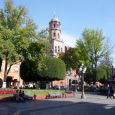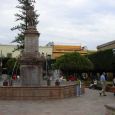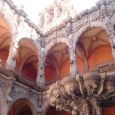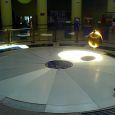Queretaro
Advertisement
By plane
Queretaro has a brand new international airport (IATA|QRO). There are direct daily flights from Houston, Texas (and soon from Dallas/Fort Worth International Airport on American Eagle). Domestic flights are expensive, so a bus may be more convenient (especially from Mexico City).
By bus
There are many buses that go to Queretaro from major cities, such as Mexico City or Guadalajara. Buses are normally inexpensive and some bus lines offer student discounts in either official Mexican holidays or the summer, winter and April vacation period. First class buses often offer movies and can be very comfortable.
The bus station is on the outskirts of the city, and features separate terminals for first-class bus lines and the local and regional second-class lines.
By car
There is toll road from Mexico City to Queretaro. It costs about 114 pesos for an automobile. The drive is about 2 hours, but add another hour for leaving/entering Mexico City.
Advertisement
Plaza de Armas
The Plaza de Independencia or Plaza de Armas is the oldest part of the city, and is filled with Indian laurel trees, surrounded by outdoor restaurants and colonial mansions. Streets here are made of cobblestone and have names such as La Calle de Bimbo and the Callejon del Ciego.In the middle of this plaza is a fountain that honors Juan Antonio de Urrutia y Arana, who built that large aqueduct to bring water to the city. Around the plaza is the Galeria Libertad (Libertad Gallery) and the Casa de Ecala (Ecala House), which is a baronial mansion from the 18th century with large balconies and wrought ironwork. However, the best-known structure on this plaza is the Palacio de la Corregiadora
Church and ex-monastery of San Felipe Neri
The Church and ex-monastery of San Felipe Neri was built between 1786 and 1805. It was opened and blessed by Miguel Hidalgo y Costilla, who also officiated the first Mass. In 1921, this church was declared the Cathedral of Queretaro by Pope Benedict XV. The church is constructed of tezontle and has altarpieces of cantera stone. The facade shows the transition between Baroque and Neoclassical architecture, and is considered to be the last Baroque facade in the city. Inside the nave is sober, austere and completely Neoclassical. The old monastery complex now houses the Ministry of Urban Development and Public Works. It is more commonly referred to as the Palace of Conin
Church and monastery of La Santa Cruz
The church and monastery of La Santa Cruz is located on Sangremal Hill, where the appearance of Saint James is said to have occurred at the founding of the city and the cross commemorating the event is kept. Both the church and the monastery are Franciscan, and in one of the few monasteries to be in operation in Mexico. This was also the site of the Colegio de la Propagación de la Fe, the first missionary school established in the Americas. From here, missionaries such as Junípero Serra set out on foot, as required by the Order, to establish missions as far away as Texas and California. During the early War of Independence, Miguel Domínguez, Queretaro's mayor and part of the 1810 Conspiracy was imprisoned here. The church has been completely restored and its main attraction is the pink stone cross that was placed on this hill in the 16th century. Its altarpieces are also of pink stone and are a mix of Baroque and Neoclassical. Tours are available here and feature how the aqueduct brought water here to cisterns, from which the residents of the city would fill their buckets. There is also a thorn tree said to have grown from the walking stick of Friar Antonio Margil de Jesús, and is considered miraculous as the thorns grow in the shape of a cross
Church and ex-convent of Santa Rosa de Viterbo
The Church and ex-convent of Santa Rosa de Viterbo is attributed to Alarife Ignacio Maraiano de las Casas and financed by Jose Velasquez de Lorea, finished in 1752. The church has twin entrances, which was common with convent churches. The two arches are decorated with mocking faces put there by Casas to those who did not think he could manage the building of the institution. The outside is flanked by scroll-shaped flying buttresses, which only serve as decoration and are unique to Queretaro. The tower has a unique shape and is topped with a pyramid-shaped crest. There is an inner doorway decorated in Churrigueresque style and an image of Saint Rose. Inside, the most outstanding feature is the pulpit inlaid with ivory, nacre, turtle shell and silver,and its altarpieces are gold covered in Queretaro Baroque style.
Church of San Francisco
In the center of downtown is the Church of San Francisco, was finished at the beginning of the 18th century and from then was the most important in town, serving as the cathedral until the 20th century. It and the attached cloister is all that is left of a large complex that included several chapels and an orchard that extended for blocks to the east and south.On the facade, there is a depicting of Saint James fighting the Moors, cutting the head off of one. The main altar is Neoclassic, and replaced what reputedly was a masterpiece of Baroque design.
The Museo de Arte
The Museo de Arte (Museum of Art) is located in the former monastery of San Agustin. The building is considered one of the major Baroque works of art in Mexico, built in the 18th century and is attributed to Ignacio Mariano de la Casa It has a facade of cantera stone in which an image of a crucified Christ is surrounded by grapevines. The niches around the main portal contain images of Saint Joseph, Our Lady of Sorrows, Saint Monica and others. Its cupola contains life-sized images of angels, but its bell tower was never finished. The monastery was occupied by Augustine friars starting in 1743 and is considered to be one of the finest Baroque monasteries in the Americas.
January - February
June - September
Information not available
Advertisement







